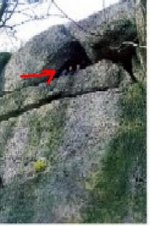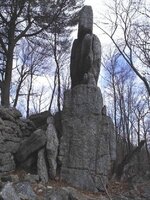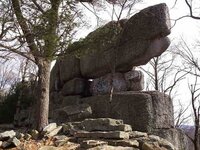Oroblanco
Gold Member
- Jan 21, 2005
- 7,838
- 9,830
- Detector(s) used
- Tesoro Lobo Supertraq, (95%) Garrett Scorpion (5%)
Re: Susquehanna County, Pennsylvania Treasure.
Afterthought - yes I wish I could locate that silver Indian bracelet found by my best friend so many years ago. I am sorry to say that he passed away some years ago as a result of cancer, and that I am not on good terms with his widow. (She refused to allow me to take his two sons hunting for the first time, as I felt that was one thing I could do for my friend since he could not) and quickly moved away after he passed on. I do know that he would have never sold the bracelet, and would have wanted it to go to his sons - but I fear that his widow may well have simply sold it to a pawn shop. She was not and is not a very nice person, in my opinion.
That bracelet had beautiful engraved designs on it, showing the Sun, Moon, stars, representations of mountains and of waters; an expert might be able to read it as a set of ideas which tell a story, but our local experts at the time could only say that it was very much pre-Columbian and of very good silver, over 90 percent pure. I wish I had taken at least a few photographs of it.
Oroblanco
Afterthought - yes I wish I could locate that silver Indian bracelet found by my best friend so many years ago. I am sorry to say that he passed away some years ago as a result of cancer, and that I am not on good terms with his widow. (She refused to allow me to take his two sons hunting for the first time, as I felt that was one thing I could do for my friend since he could not) and quickly moved away after he passed on. I do know that he would have never sold the bracelet, and would have wanted it to go to his sons - but I fear that his widow may well have simply sold it to a pawn shop. She was not and is not a very nice person, in my opinion.
That bracelet had beautiful engraved designs on it, showing the Sun, Moon, stars, representations of mountains and of waters; an expert might be able to read it as a set of ideas which tell a story, but our local experts at the time could only say that it was very much pre-Columbian and of very good silver, over 90 percent pure. I wish I had taken at least a few photographs of it.
Oroblanco


 About the pyramids: you give a lot of good examples of idea exchange through trade. Egypt seeing the mud brick pryamids of the Sumerian's... I buy that. Only logical. The Romans seeing the great pyramids- for sure. So on and so forth... okay. The problem I have is that all of your examples in the old world involve cultures who were previously unexposed to pyramid building going somewhere, seeing them, and taking the tale/idea back to their native land. This leads me to believe that it would have been necessarily the case that a Mayan or other native at some point traveled somewhere to see pyramids. Now I know you're going to say No, the idea was transferred not the native. Two things about that: if this Carthaginian contact was accidental/sporadic at best how many cultural traits are going to be transferred? If you have a Carthaginian trade vessel that accidentally blows across the ocean (which by the way is one of the ideas that I find most plausible vs. intentional exploration) and they come on shore to re-supply and end up doing a little trading with the natives then is pyramid building going to be transferred also? Take any culture steeped in their religious beliefs for hundreds or even thousands of years and let them have contact with a new culture, however brief it may be and I think you will see both of the cultures walking away with something new but more likely than not it won't be a whole new belief system. Although then I think of the cocoa and tobacco in the Egyption mummies and have to wonder if the contact was more than sporadic...I guess that when I'm standing in the middle of nowhere Wisconsin, deep in the woods looking at a burial mound/effigy mound that is four feet tall and circular in shape it just makes the ancients and the birth of western civilization seem quite distant indeed.
About the pyramids: you give a lot of good examples of idea exchange through trade. Egypt seeing the mud brick pryamids of the Sumerian's... I buy that. Only logical. The Romans seeing the great pyramids- for sure. So on and so forth... okay. The problem I have is that all of your examples in the old world involve cultures who were previously unexposed to pyramid building going somewhere, seeing them, and taking the tale/idea back to their native land. This leads me to believe that it would have been necessarily the case that a Mayan or other native at some point traveled somewhere to see pyramids. Now I know you're going to say No, the idea was transferred not the native. Two things about that: if this Carthaginian contact was accidental/sporadic at best how many cultural traits are going to be transferred? If you have a Carthaginian trade vessel that accidentally blows across the ocean (which by the way is one of the ideas that I find most plausible vs. intentional exploration) and they come on shore to re-supply and end up doing a little trading with the natives then is pyramid building going to be transferred also? Take any culture steeped in their religious beliefs for hundreds or even thousands of years and let them have contact with a new culture, however brief it may be and I think you will see both of the cultures walking away with something new but more likely than not it won't be a whole new belief system. Although then I think of the cocoa and tobacco in the Egyption mummies and have to wonder if the contact was more than sporadic...I guess that when I'm standing in the middle of nowhere Wisconsin, deep in the woods looking at a burial mound/effigy mound that is four feet tall and circular in shape it just makes the ancients and the birth of western civilization seem quite distant indeed. 

 ) Of course this way of looking at it would mean that the pyramids were most likely independent inventions also. Now if you're going to go argue with the pros or even somebody who knows there stuff unlike me then you're going to have to argue it one way or the other, can't have the cake and eat it too.
) Of course this way of looking at it would mean that the pyramids were most likely independent inventions also. Now if you're going to go argue with the pros or even somebody who knows there stuff unlike me then you're going to have to argue it one way or the other, can't have the cake and eat it too. 



